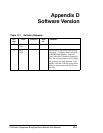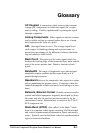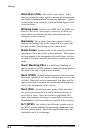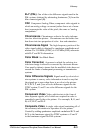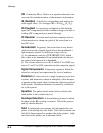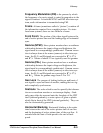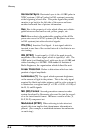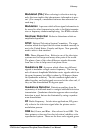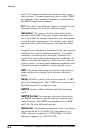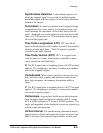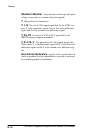
Glossary
1760 Series Component Waveform/Vector Monitor User Manual
G-5
Frequency Modulation (FM) is the process by which
the frequency of a carrier signal is varied in proportion to the
signal of interest. In both the NTSC and PAL television sys-
tems, audio information is transmitted using FM.
Frame A frame (sometimes called a “picture”) contains all
the information required for a complete picture. For inter-
laced scan systems, there are two fields in a frame.
Front Porch The portion of the video signal between the
end of active picture time and the leading edge of horizontal
sync.
Gamma (NTSC) Since picture monitors have a nonlinear
relationship between the input voltage and brightness, the
signal must be correspondingly predistorted. Gamma correc-
tion is always done at the source (camera) in t elevision sys-
tems: the R, G, and B signal s are convert ed to R
1
/
V
,G
1
/
V
,
and B
1
/
V
. Values of about 2.2 are typically used for gamm a.
Gamma (PAL) Since picture monitors have a nonlinear
relationship between the input voltage and brightness, the
signal must be correspondingly predistorted. Gamma correc-
tion is always done at the source (camera) in t elevision sys-
tems: the R, G, and B signal s are convert ed to R
1
/
V
,G
1
/
V
,
and B
1
/
V
. Values for gamma range from 2.2 to 2.8.
Gen Lock The process of locking both sync and burst of
one signal to sync and burst of another, making the two sig-
nals completel y synchronous.
Graticule The scale which is used to quantify the informa-
tion on a waveform monitor or vectorscope display. Grati-
cules may either be screened onto the faceplate of the CRT
itself (internal graticule), or onto a piece of glass or plastic
which fits in front of the CRT (external graticule). They can
also be electronicall y gene rated.
Horizontal Blanking Horizontal blanking is the entire
time between the end of the active picture time of one line
and the beginning of active picture time of the next line. It
extends from the start of front porch to the end of back
porch.



